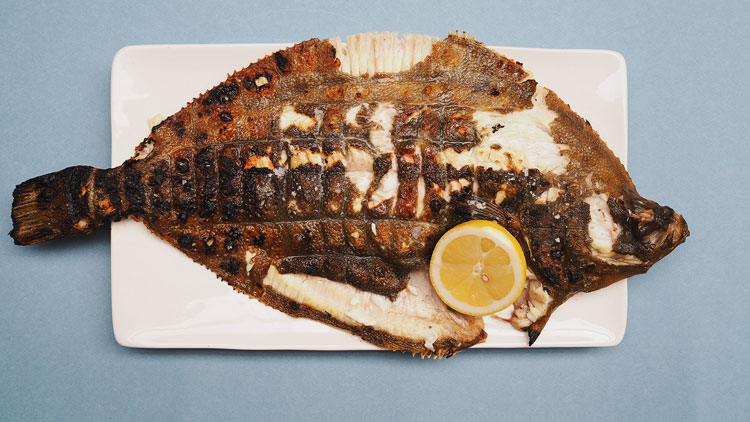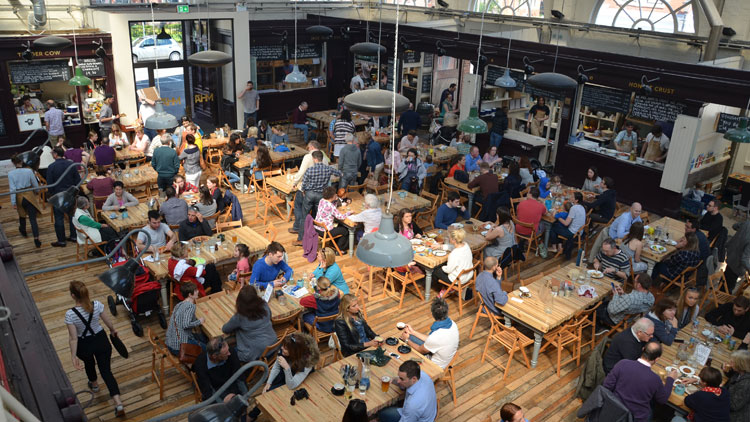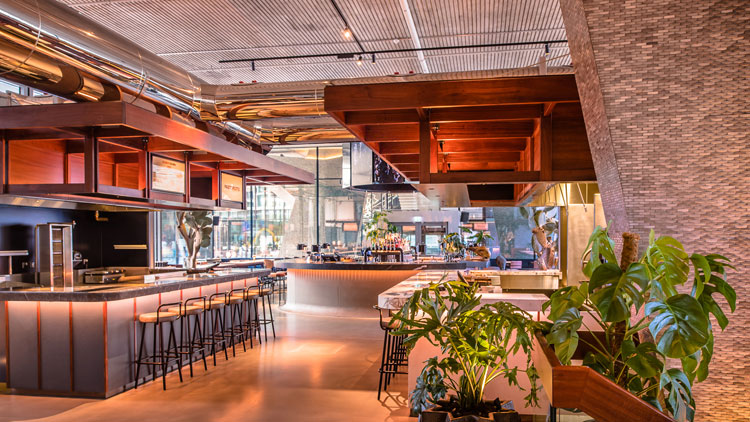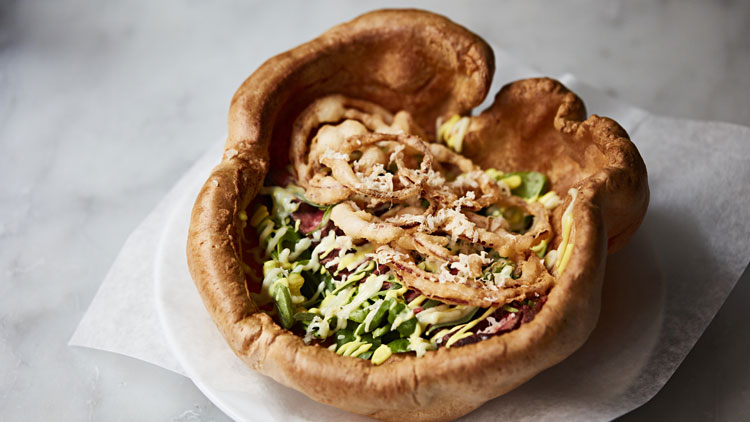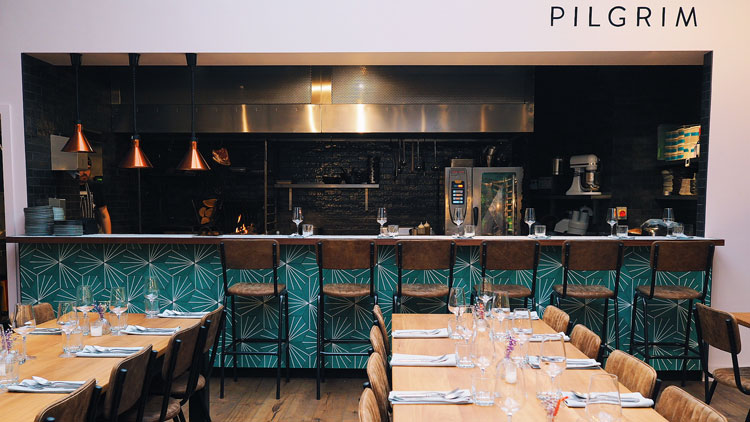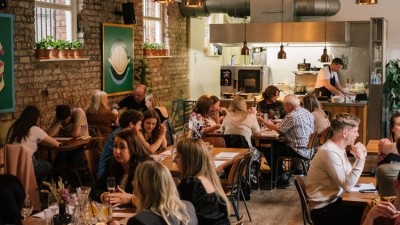Market forces: why food halls are now a major part of the eating out market
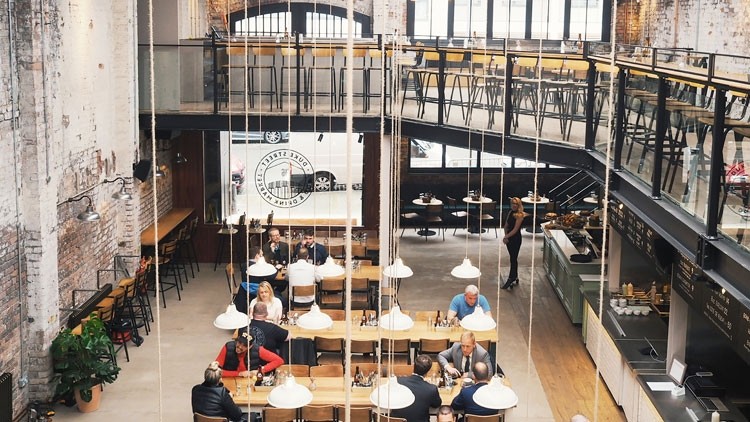
Google any British city or mid-sized town and the words ‘food hall’ and almost certainly you will discover reports of proposed openings. From Barry to Durham via Warrington, councils, developers and food entrepreneurs are looking to mimic the success of outfits such as Market Operations, which runs the pioneering Altrincham Market House and Manchester’s Mackie Mayor, or London’s Market Halls, which will open a third, vast 800-seat West End food hall later this year.
In cities such as Liverpool (Baltic Market, Dockside Dining Club, Duke Street Market), or London (Arcade Food Theatre, just opened; KERB Seven Dials Market, which opened last month; Eataly and The Market, both due to open in Bishopsgate in 2020; and Time Out Waterloo in 2021), it is difficult to stay abreast of new and future openings, such is the clamour around food halls. Market Halls’ Victoria site has served almost one million people since it opened in late 2018 – evidence, says CEO Simon Anderson, of how the format of lively communal dining from multiple kitchens is how people want to eat right now.
“We’ve done research into why people come here,” says Anderson. “First is location, second is vibe. Interestingly, specific traders come low [down], and although we’re more guarded about the money we spend – I’d rather give £10 to a street food stall than a chain – value-for-money isn’t a massive draw.
“People are looking for somewhere fun, vibey, nearby, which offers choice. Everyone is becoming fussier and, here, people can do and eat their own thing without worrying about a shared bill.”
Nurturing environments
Essentially a high street’s-worth of independent operators rolled into a convenient one-stop lifestyle destination (DJs/live music, tastings, events, occasional open-air markets), many observers see no reason why cities could not support multiple distinctive food halls in different neighbourhoods, as is common in major European cities.
That prospect opens up interesting opportunities for street food traders; self-employed chefs keen to launch fresh concepts; and restaurants looking to expand cost-effectively. Liverpool’s Baltic Market is just such an incubator. At least three of its traders (Little Furnace, Hafla Hafla, Midnight Delivery), have subsequently launched standalone bricks and mortar sites while continuing to operate
their Baltic units.
Typically, food halls charge tenants a percentage of turnover up to 30% (15% at Baltic Market; 25% at Market Halls) in return for a base kitchen-retail unit with extraction, refrigeration, power and till (Baltic Market tenants get an iPad and iZettle account), with all utilities and waster removal covered. Shopping cannily using second-hand equipment, a chef looking to test a concept could kit out that unit for around £5,000-£10,000.
“We’re trying to make the barrier to entry as low as possible,” says Anderson. By taking a share of turnover, Market Halls has a vested interest in its partners’ success. “We’ve got skin in the game, so it’s in our interests to make them successful as well.”
Initial three, six or even 12-month leases for established brands offer a financial safety net for both parties. But in contrast to the early street food markets, the churn of traders is slowing. Most food halls regularly change 10–20% of traders to keep their offer fresh, but traders offering high-quality versions of popular staples, such as burgers and pizza, can easily become permanent fixtures.
“When we opened, I thought people would get bored and want new traders all the time, but it was too much, says Baltic Market co-founder David Williams. “If people really enjoy one trader, they want to visit them again.”
Unlike the traditional landlord-tenant relationship, better food halls are nurturing environments where the management maintains a dialogue with traders about things such as pricing, menu design, new dishes, branding, and promotion via social media, not least to ensure there is no duplication between traders. Experienced chefs may find such oversight irritating, but for collegiate traders and, particularly, inexperienced newcomers, that infrastructure can be invaluable.
“It’s like being in a shared house versus having your own place,” says Aarti Ormsby, owner of Chaat Cart restaurant in Stockport, a kiosk in Sheffield’s Kommune, and a third, new outlet in Stockport’s Produce Hall. Kommune, she says, offers ‘wraparound care’. This takes many forms, from having its own bespoke EPoS system or an in-house photographer to shoot all the units (for consistent visual branding in its PR), to directly employing KPs to handle all back-of-house duties, including cleaning Kommune’s branded crockery.
“They’ve really thought it through. Compared with restaurants, which have lots of moving parts, Kommune is much easier,” says Ormsby. “You don’t have to worry about the bar, wet sales, front-of-house or the KPs. Kommune directly employs runners to deliver food. Other food halls prefer a buzzer-customer-collection system.”
Making concepts work
Isolating what concepts work in this environment, both in branding, building a menu, pricing and the logistics of delivering it, can still take time. Richard Carver runs two units at Altrincham’s Market House: a hugely popular and respected Neapolitan pizzeria, Honest Crust; and what he jokily describes as his “vanity project”, Little Window.
Unlike Honest Crust, Little Window, which serves ‘simple seasonal Mediterranean cooking’ did not work at sister site Mackie Mayor and it will not feature at Market Operations’ next Macclesfield site. “At Mackie no one really had a clue what Little Window was or what our menu was about. It wasn’t obvious enough in terms of its menu design and identity, and we underestimated that. We did an ox heart dish that we absolutely loved… but it sold one portion,” says Carver.
The street food and food hall scenes have a reputation for being fun, fast-moving, foodie and fashionable; the first places to popularise new dishes and influences from East Asia or South America, for instance. But that newsworthy headline rather misrepresents what, at its core, can be a quite conservative environment. These are family-friendly, mass-market outlets and busy places where people want to make quick decisions.
Consequently, the more unusual dishes that take off tend to be crowd-pleasing and Insta-friendly (think bubblewrap waffles rather than Szechuan offal dishes), and often people simply opt for familiar products. “People go for the path of least resistance. You need to pitch at an accessible level,” says Anderson.
Altrincham’s Little Window is finally making money but, in contrast to Honest Crust’s production-line efficiency, its constantly evolving menus and in-the-moment cooking, using just a flat-top, an electric grill and two induction hobs, mean it requires a disproportionate amount of planning and hard graft – not least to ensure quick service at peak times. Designing dishes that can be replicated quickly at volume to a high standard (Baltic Market attracts up to 5,000 visitors every Saturday), can be difficult. In food halls, people expect to be served almost immediately. A 20-minute wait is thought a real inconvenience.
“Weekend brunch can be pretty horrendous when you’re knocking out 30 mushrooms-on-toast an hour. We don’t do different styles of eggs, it would be absolute chaos,” says Carver. Working under that pressure, in an open unit, requires calm staff, too. They need to be at ease cooking but also taking orders and chatting with customers. As Ormsby cautions: “Chefs aren’t always the most patient, and there’s nowhere to hide!”
There are exceptions. Quick wok and grill cooking suits food halls, and some traders – dim sum stalls or Roti King’s Gopal’s Corner at Market Halls Victoria – can deliver longer menus from modular components. But generally short, easily navigated menus of four-to-six mains and a few sides work best, which diners can combine as a complete meal for £7-£12.
“Big menus, particularly where people had to choose meat and veg options, didn’t work,” says Williams. Anderson agrees: “There is the danger it can become the Netflix of food when people are here and they’re just dazzled by the amount of choice. Price-point is important too, it needs pitching correctly. If someone has really cheap dishes, a more expensive menu will suffer [regardless] of quality.”
Competing with the high street
The losers in all this seem to be high street brands that have committed to expensive sites in high footfall areas, only to see custom snatched from under their noses by traders with significantly lower costs and overheads. Whereas in London the first group of food halls tended to either stay away from more established restaurants’ business, certainly in the daytime, either because they were located in less central locations such as Fulham, or operated only a few days a week and often at night, such as Dinerama in Shoreditch, the new breed are parking their tanks on some very central and high footfall lawns.
Located underneath Centre Point, the newly opened Arcade Food Theatre, for example, is very much in a position to steal restaurant trade from nearby Soho, where rents have steadily risen in recent years. Likewise, at the other end of Oxford Street, the new Market Hall West End will open in a prime position where restaurant businesses have traditionally had to pay handsomely for the large amount of footfall.
And then there’s KERB Seven Dials Market on Earlham Street, linking Soho to Covent Garden, which plays host to a second site for Japanese restaurant Nanban (as well as a pasta-focused restaurant from the team behind Franco Manca), again allowing established operators an entry into an expensive and sought-after part of the capital.
As Dave Strauss, former Burger & Lobster managing director and now restaurant director at Rockfish, recently tweeted: ‘So we have Market Halls opening by Oxford St, Arcade Food at Tottenham Court Rd and KERB Market at Seven Dials. That has to be a triangle of death to operators paying top £ rent in Soho.’
In the case of Seven Dials Market, the split-level operation has even more of a restaurant feel to it than some of the other food halls. While the downstairs area, with its bar and communal dining areas, feels similar to the likes of Arcade Food Theatre and Duke Street Market, where customers order food and drink from different traders and then eat in the designated area, its upstairs traders take a more traditional restaurant approach (see Pilgrim’s progress, overleaf). At cheese conveyor restaurant Pick & Cheese, for example, diners can reserve either of its two booths and can also order drinks from its wine list. Other sites upstairs also have designated seating areas: with around 30 covers, the Monty’s Deli there is of a similar size to its recently closed flagship restaurant in Shoreditch.
Taking bookings means that KERB will attract Covent Garden’s theatre crowd, according to CEO Simon Mitchell, and will remove the last difference between food halls and restaurants. Seven Dials Market also features a bookshop that will double as a PDR at night, with customers able to book it and eat the dishes from the various traders. “We don’t want this to be seen as just another food hall but as something with more depth and texture,” he says.
The more the merrier
Just as overcrowding in the sector and over-expansion created problems for the casual dining sector, could the same potentially happen with food halls in areas where some already exist and more are planned? If the first phase of food halls essentially took the street food market indoors, the next phase may well see greater specialisation (see the self-explanatory Asia Asia in Birmingham), and diversification in how halls look and feel. For instance, the glitzy Eataly dining and shopping experience is far removed from Baltic Market’s or Dinerama’s or Hawker House’s gritty, DIY aesthetic.
Anderson – whose Market Halls will initially focus on expanding in London and via Intu shopping centres around the country – believes that, certainly in the short term, there is room for new entrants. But, as the recent woes of the casual dining market have shown, with brands cutting their cloth in the face of rising food, property and staff costs, to negative effect, he says the future of such projects is reliant on high quality and creating points of difference rather than just regarding food halls as the next sure-fire vehicle to make a quick buck.
“There’s definitely a sweet spot for it for the next few years, as long as people run them well,” he says. “As long as quality is high and traders operate efficiently.” KERB also believes that London can yet sustain many more food halls. “People say there are a lot of food halls but there aren’t that many,” says Mitchell.
“How many supermarkets and shopping centres are there in London? It’s just quite a new phenomenon for London. We went to New York two years ago and there were 20 food halls there, and there’s only five or six in London. We’re catching up with other cities and there’s room for more. It’s how people want to eat now, it’s more sociable.”
“Clustering is the whole mantra of the KERB business, it’s a human instinct to cluster,” adds KERB founder Petra Barran.
“It’s great to open a restaurant miles away from anyone else if you can get good rent, but the reality is people aren’t necessarily going to come there as there’s not enough reason to. It’s giving people plenty of reason to come somewhere.”
Pilgrim’s progress: the full-service food hall restaurant
Up on the mezzanine at Liverpool’s Duke Street Market, subtly demarcated by table settings, aproned staff and a larger, open kitchen, sits Pilgrim. It is an unusual location in which to encounter this former London-based pop-up (as featured on BBC2’s Million Pound Menu), but given that Duke Street’s co-owners, Graffiti Spirits Group, offered to finance Pilgrim’s kitchen and restaurant fit-out and guarantee them a year here (Duke Street takes a percentage of turnover), it was a low-risk offer too good to refuse. “Doing this off our own backs would have been a huge financial burden. It’s an incredible opportunity,” says Jamie Duffield, one of Pilgrim’s three owners.
While Duffield liaises with Cinder or Bone And Block downstairs to avoid inadvertent menu clashes, he says: “It’s important to define Pilgrim as part of the market, but not defined by the market.” Pilgrim gains atmosphere and exposure from its position in this high-footfall space (the noise is a problem for some diners, however), but retains its own PR company, aware it must sell itself as a standalone destination.
Its Iberian menu is currently three-dishes-for-£15 at lunch and while that “marketing tool” may “capture some incidental footfall”, it was primarily set at that rate to make Pilgrim competitive
with nearby restaurants such as Wreckfish or Maray, not Duke Street’s street food outlets. In that regard, Pilgrim could be anywhere in Liverpool.
This is a web version of an article that first appeared in the October issue of Restaurant magazine, the leading title for the UK's restaurant industry. For more features, comment, interviews and in-depth analysis of the restaurant sector subscribe to Restaurant magazine here.
Follow Tony on Twitter: @naylor_tony
